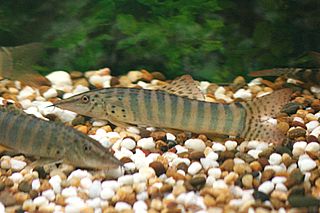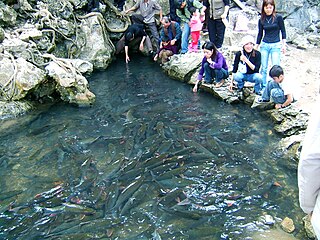
The Mekong or Mekong River is a trans-boundary river in East Asia and Southeast Asia. It is the world's twelfth-longest river and the third-longest in Asia with an estimated length of 4,909 km (3,050 mi) and a drainage area of 795,000 km2 (307,000 sq mi), discharging 475 km3 (114 cu mi) of water annually. From its headwaters in the Tibetan Plateau, the river runs through Southwest China, Myanmar, Laos, Thailand, Cambodia, and southern Vietnam. The extreme seasonal variations in flow and the presence of rapids and waterfalls in the Mekong make navigation difficult. Even so, the river is a major trade route between Tibet and Southeast Asia. The construction of hydroelectric dams along the Mekong in the 2000s through the 2020s has caused serious problems for the river's ecosystem, including the exacerbation of drought.

The Chao Phraya is the major river in Thailand, with its low alluvial plain forming the centre of the country. It flows through Bangkok and then into the Gulf of Thailand.

Nam Ngum is a 354 km long river in Laos. It is a major tributary of the Mekong River.

Balantiocheilos is a small genus of cyprinid fish from southeast Asia. It includes two species.

Yasuhikotakia modesta is a tropical freshwater fish of the family Botiidae. It is native to large rivers in Thailand, Laos, Cambodia, and Vietnam. The blue botia is a widely available fish in the aquarium trade and can be purchased globally.

Botiidae is a family of cypriniform ray-finned fishes from South, Southeast, and East Asia. Until recently they were placed in the true loach family Cobitidae, until Maurice Kottelat revised the loaches and re-elevated this taxon to family rank in 2012. The family includes about 56 species.

Bagarius rutilus is a species of sisorid catfish native to Laos, Vietnam and Yunnan in China where it is found in the Nam Sam, Nam Ma and Red River basins. This species grows to a length of 100 centimetres (39 in) SL.
Systomus jacobusboehlkei is a species of cyprinid fish native to the lower Mekong and Chao Phraya Basins of Cambodia, Vietnam, Laos, and Thailand. It inhabits marshlands and floodplains, swamps, and small, slow-flowing tributaries. It is present in local food fisheries, along with other small species. This species can reach a length of 12 centimetres (4.7 in) SL.
Schistura aramis is a species of ray-finned fish in the stone loach genus Schistura from the Nam Nua catchment, a tributary of the Nam Ou in Laos, it may also possibly occur in Vietnam. The specific name comes from one of Alexandre Dumas' The Three Musketeers, Aramis as do that of two other Schistura species endemic to the Nam Ou basin, S. athos and S.porthos.
Schistura athos is a species of ray-finned fish in the stone loach genus Schistura, its specific name athos is from, Athos, one of the Three Musketeers by Alexandre Dumas, as do that of two other Schistura species endemic to the Nam Ou basin, S. aramis and S.porthos. It has only been recorded from the Nam Ou basin in Laos, as well as from a stretch of the Nam Noua, a tributary of the Nam Ou, in Vietnam. S. athos has been collected from rapids and stretches of the main river with stone substrates.
Schistura finis is a species of ray-finned fish in the genus Schistura, the most speciose of the stone loach genera. It has only been recorded from small streams in the headwaters of the Nam Mo River on the frontier between Laos and Vietnam.
Schistura magnifluvis is a species of ray-finned fish, a stone loach, in the genus Schistura. It is found in the middle Mekong basin in Thailand and Laos, from the Nam Heung basin to the Xe Don system, it probably occurs in Cambodia too. It is found in streams and rivers, including the nmain channel of the Mekong, in stretches of moderate to fast current over a variety of substrates from mud to stone.
Schistura porthos is a species of ray-finned fish in the stone loach genus Schistura from the Mekong basin; the Nam Ngiap, Nam Khan, Nam Xuang, Nam Ou and Nam Tha drainages in northern Laos and the Luosuojiang drainage in Xishuangbanna, Yunnan. The specific name comes from one of Alexandre Dumas' The Three Musketeers, Aramis as do that of two other Schistura species endemic to the Nam Ou basin, S. athos and S.aramis.
Cyprinus melanes is a species of ray-finned fish in the genus Cyprinus from the Kiến Giang River basin in Vietnam.

Bolikhamsai is a province of Laos. Pakxan, Thaphabat, Pakkading, Borikhane, Viengthong, and Khamkeut are its districts and Pakxan is its capital city. The province is the site of the Nam Theun 2 Dam, the country's largest hydroelectric project.
Scaphiodonichthys acanthopterus is a freshwater fish of the family Cyprinidae. It is found in clear, fast-moving streams and tributaries of the Mekong, Nam Xam, Da and Chao Phraya river basins in Indochina. S. acanthopterus is most commonly found in waterways with a rocky bottom and under complete tree cover.
Pseudohemiculter dispar is a species of freshwater ray-finned fish from the family Cyprinidae, the carps and minnows from south east Asia. It occurs in the Mekong and Nam Ma basins in Laos, central and northern Vietnam, and southern China.
Hemibarbus macracanthus is a species of small freshwater fish in the family Cyprinidae. It is endemic to China.
Scaphiodonichthys macracanthus is a species of cyprinid fish of the genus Scaphiodonichthys. It inhabits inland wetlands in Yunnan, China and Vietnam. It has been assessed as "data deficient" on the IUCN Red List. It has a maximum length of around 21 cm (8.3 in). It is considered harmless to humans.

Spinibarbus denticulatus, the phoenix barb or Chinese phoenix barb, is an Asian species of cyprinid freshwater fish of the subfamily Spinibarbinae. This fish is found in China in the Yuanjiang and Pearl basins, freshwater systems of Hainan, and Yangzong and Fuxian Lakes, in Laos in the Mã basin, and in Vietnam in the Red, Gâm, Lô and Mã basins, and freshwater systems from Nghệ An to Quảng Trị province. It occurs in large to medium rivers, deep pools of streams, in lakes and reservoirs, and it has a quite broad temperature tolerance, between at least 9 and 30 °C (48–86 °F) depending on season. Overall the species is widespread, but some local populations have been reduced due to overfishing, habitat loss and pollution. It is an important food fish that sometimes is aquacultured, and also kept as a garden pond or aquarium fish. Large numbers of the species can be found in the Cẩm Lương stream in Cẩm Thủy, Vietnam, where it is considered sacred and the locals protect and feed it, and it is also a tourist attraction.









